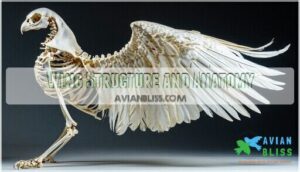This site is supported by our readers. We may earn a commission, at no cost to you, if you purchase through links.
 You’re looking at this backwards – flightless birds didn’t evolve to have wings again after losing flight.
You’re looking at this backwards – flightless birds didn’t evolve to have wings again after losing flight.
Instead, they evolved from flying ancestors and lost their ability to fly while keeping their wings. Recent genetic research shows that different flightless bird species like ostriches, emus, and kiwis lost flight through remarkably similar genetic changes, even though they evolved separately.
Scientists discovered that specific regulatory regions in their DNA control body proportions and wing development. When these regions mutate, birds develop larger bodies and smaller, weaker wings that can’t support flight.
This process happened multiple times across bird evolution, creating today’s flightless species through convergent evolution – nature’s way of arriving at similar solutions independently, resulting in flightless species with smaller wings and larger bodies.
Table Of Contents
- Key Takeaways
- How Did Flightless Birds Evolve to Have Wings Again?
- The Evolution of Flightless Birds
- Genetic Mechanisms Behind Flight Loss
- Impact of Regulatory Regions on Flightless Birds
- Convergent Evolution of Flightless Birds
- Understanding Bird Wings and Flight
- Frequently Asked Questions (FAQs)
- How did flightless birds evolve?
- How did birds evolve to get wings?
- What flightless bird evolved twice?
- How did the flightless birds evolve?
- Why do flightless birds still have wings?
- Why do emus have wings if they can’t fly?
- Can flightless birds regain the ability to fly?
- How long does it take for birds to lose flight?
- Are there transitional species between flying and flightless birds?
- Do flightless birds have different feather structures?
- Conclusion
Key Takeaways
- You’ll find that flightless birds didn’t evolve wings again – they’re descendants of flying ancestors who gradually lost their flight ability while keeping their wing structures for new purposes like balance, display, and thermoregulation.
- You’re seeing convergent evolution in action, where unrelated bird species like ostriches, emus, and kiwis independently developed similar flightless traits by targeting the same regulatory DNA sequences that control wing development.
- You’ll discover that specific genetic mutations in regulatory regions consistently create larger bodies with smaller, weaker wings across different flightless species, showing evolution’s limited pathways for losing flight while preserving basic wing anatomy.
- You’re witnessing evolutionary repurposing rather than reversal – these birds transformed their wings into specialized tools for survival (penguin flippers for swimming, ostrich wings for running balance) instead of regaining their ancestors’ flying abilities.
How Did Flightless Birds Evolve to Have Wings Again?
The mystery of flight reversal isn’t quite what you’d think.
Flightless birds don’t actually regrow functional wings through evolutionary reversal.
Evolution doesn’t reverse—it repurposes wings for new survival strategies.
Instead, wing regeneration involves repurposing existing wing structures for new functions.
When environmental pressures shift, dormant genes can reactivate through epigenetic changes like DNA methylation.
These evolutionary adaptations showcase remarkable species resilience.
Wing reevolution occurs when regulatory pathways alter protein synthesis, modifying wing development timing and location.
Flight loss research reveals that while true flight rarely returns, wings adapt for balance, display, swimming, or thermoregulation.
This bird re-evolution demonstrates nature’s creative problem-solving rather than simply reversing flightless bird evolution.
The study of flightless bird traits helps us understand the complex relationships between wing structure and functional adaptations.
The Evolution of Flightless Birds
You’ve likely wondered how birds that can’t fly ended up with wings at all, and the answer lies in understanding that flightless birds didn’t evolve wings again—they evolved FROM flying ancestors and then lost the ability to fly.
The fascinating part isn’t about regaining flight, but rather how these birds repeatedly evolved similar flightless adaptations through remarkably consistent genetic pathways across completely different lineages, which is a remarkably consistent aspect of their evolution.
Genetic Mechanisms
Understanding genetic mechanisms behind flightless birds reveals nature’s toolkit for evolutionary change.
These birds didn’t lose their wings by accident—specific genetic shifts made flight unnecessary in their environments.
Key Genetic Mechanisms in Wing Evolution:
- Gene Expression modifications alter when and where wing development genes activate, creating smaller or modified wing structures
- Mutation Rates in regulatory genes increase during environmental pressure, accelerating adaptive changes in wing morphology
- Epigenetic Factors like DNA methylation silence flight-related genes without permanently changing DNA sequences
- Regulatory Genes governing limb development experience targeted mutations that preserve basic wing structure while eliminating flight capability
- DNA Sequencing reveals conserved genetic pathways across different flightless species, showing evolutionary biology’s repeated solutions
These genetic mechanisms demonstrate evolutionary reversal—traits can be modified rather than completely lost.
Wing regeneration becomes possible because the underlying genetic framework remains intact, just switched off or redirected for new functions like balance, display, or thermoregulation.
Multidisciplinary Research
You’ll find that researching flightless birds requires teamwork across different fields.
Scientists from Harvard and other institutions combined their expertise to crack the genetic code behind flight loss.
This multidisciplinary research approach proved essential for understanding evolutionary biology and genetic mechanisms.
| Research Methods | Team Collaboration | Scientific Implications |
|---|---|---|
| Genome sequencing | Developmental biologists | Reveals bird wing evolution patterns |
| Statistical analysis | Computational experts | Shows evolutionary convergence |
| Comparative studies | Ornithologists | Explains flight loss mechanisms |
| Data analysis | Multiple institutions | Advances genetic research |
The team’s funding sources included the National Science Foundation and Canadian research councils, enabling thorough analysis of over a dozen species.
Their collaborative effort revealed that similar regulatory pathways control wing development across different flightless lineages, demonstrating how diverse expertise strengthens scientific discovery.
Understanding flightless bird traits is vital for explaining the evolution of these unique species.
Convergent Evolution
Looking at flightless birds through an evolutionary lens, you’ll discover fascinating examples of Species Convergence where nature repeatedly finds similar solutions to environmental challenges.
This remarkable process demonstrates how Environmental Pressures shape life in predictable ways.
Convergent evolution occurs when unrelated bird species independently develop similar Adaptive Traits for survival.
Consider how different lineages have tackled the same problem:
- Regulatory pathway targeting – Multiple species evolved flightlessness by altering the same wing evolution control mechanisms, showing limited genetic routes to flight loss.
- Morphological similarity – Despite different ancestries, flightless birds share reduced forelimbs and modified breastbones, illustrating Evolution Patterns driven by physics and function.
- Environmental specialization – Penguins transformed wings into flippers while ostriches developed powerful running legs, both responding to specific ecological niches.
What’s particularly intriguing is that flightless bird evolution doesn’t represent permanent loss.
Reversal evolution suggests these birds could theoretically regain flight if environmental conditions changed, though Genetic Drift makes this increasingly unlikely over time.
Genetic Mechanisms Behind Flight Loss
You’ve uncovered the surprising genetic story behind flight loss—it’s not random but follows predictable molecular patterns.
Scientists have discovered that when birds lose their ability to fly, the same regulatory DNA sequences get targeted again and again, creating a genetic roadmap that explains how wings transform from flight engines into balance tools, display props, or swimming paddles.
Analysis of Flightless Bird Genomes
Scientists discovered flight genetics secrets by analyzing flightless bird genomes, revealing how evolution repeatedly targets the same regulatory pathways.
Through genome mapping of species like ostriches, kiwis, and extinct moas, researchers discovered over 1,000 conserved regulatory elements linked to flight loss. These genetic coding patterns show remarkable consistency across different bird lineages.
The study of bird genome analysis involves understanding genetic data tools to interpret the complex relationships between genes and flight capabilities.
Bird Species Genome Sequenced Findings
This genomic detective work reveals that vestigial wings aren’t random accidents—they’re the result of predictable genetic regulation changes that repeatedly occur during species adaptation and evolutionary reversal processes.
Regulatory Pathways
Regulatory pathways orchestrate the complex dance of gene regulation that transforms flying ancestors into flightless descendants.
You’ll discover these molecular networks control everything from wing development to muscle formation through precise DNA binding and protein expression patterns.
Here’s how regulatory genes reshape flightless birds:
- WNT and FGF signaling pathways restrict limb development while preserving vestigial wing structures for display and thermoregulation
- BMP pathway downregulation inhibits full wing outgrowth, creating the perfect balance between function and form
- Growth factor modifications like altered IGF1 and IGF2 expression reduce wing muscle mass across multiple flightless lineages
These pathway evolution changes represent nature’s toolkit for developmental biology, showing how genetic regulation fine-tunes evolutionary genetics without completely scrapping the original blueprint.
Conserved Regulatory Regions
Genome research methods have revealed that conserved regulatory regions act like genetic blueprints, controlling when and where flight-related genes turn on or off.
Through DNA sequencing and gene expression analysis, you’ll find these regions consistently targeted across different flightless bird species.
Think of it this way: while the genetic code itself stays mostly intact, the control switches get rewired.
Regulatory genes governing wing development undergo similar modifications in ostriches, emus, and penguins—despite these birds evolving flightlessness independently.
This pattern shows up repeatedly in evolutionary genetics research.
Epigenetics adds another layer, with DNA methylation patterns silencing flight-specific pathways while preserving basic wing structure.
The limited genetic pathways available for losing flight explain why genetic regulation research finds such striking similarities.
These regulatory regions represent evolutionary bottlenecks—there’s basically only one efficient way to shrink wings while keeping them functional for balance, display, or thermoregulation.
Impact of Regulatory Regions on Flightless Birds
You’ll discover how regulatory DNA sequences act as master switches, controlling when and where wings develop in bird embryos.
These same genetic control regions get repeatedly targeted during evolution, creating remarkably similar wing reduction patterns across completely unrelated flightless bird species, which is a result of evolution.
Role in Body-Scaling Changes
When examining flight loss evolution, body scaling becomes a masterpiece of genetic engineering.
Your flightless birds undergo dramatic morphology shifts through precise growth patterns that reshape their entire anatomy. These regulatory regions orchestrate wing reduction while maintaining essential limb development for terrestrial life.
Consider how these body-scaling changes revolutionize survival:
- Size variation allows massive ostriches to outrun predators at 45 mph
- Wing function diversity transforms penguin wings into underwater propulsion systems
- Flight adaptations become running adaptations, trading sky mobility for ground speed
- Bird wing diversity showcases nature’s creativity in repurposing existing structures
This intricate dance between genes and environment creates functional solutions that’d make any engineer jealous.
Loss of Forelimbs
When you examine the forelimb reduction in flightless birds, you’re witnessing one of evolution’s most dramatic structural makeovers. The loss of functional wings didn’t happen overnight—it’s the result of precise genetic choreography that transformed flying ancestors into ground-dwelling specialists.
Forelimb Reduction occurs through targeted changes in regulatory DNA sequences that control limb development. Unlike hind limbs, which remain robust for running, forelimbs shrink dramatically while maintaining basic skeletal frameworks. Wing Atrophy varies among species—emus show extreme reduction with vestigial structures, while ostriches retain larger, more functional wings for balance and display.
Limb Development follows an "initiate-and-delay" pattern where wing buds begin normally but halt proliferation due to reduced fibroblast growth factor expression. This creates the spectrum of wing sizes across flightless species.
Here’s how Skeletal Changes and Muscular Adaptations reshape these birds:
- Breastbone modification: Loss of the keel eliminates the anchor point for powerful flight muscles
- Bone density shifts: Denser bones replace hollow flight-adapted structures for terrestrial stability
- Muscle reallocation: Energy formerly devoted to flight muscles redirects toward stronger leg development
This evolutionary reversal demonstrates nature’s efficiency in eliminating costly, unused features. The study of Fgf signaling patterns provides insights into the molecular mechanisms underlying forelimb reduction in flightless birds.
Repeated Convergent Evolution
Nature’s evolutionary playbook reveals fascinating patterns when you examine how flightless birds repeatedly evolved similar traits.
You’ll discover that convergent evolution creates remarkable parallels across unrelated species, demonstrating how genetic code constraints shape adaptive traits in predictable ways.
| Evolution Patterns | Genetic Code | Adaptive Traits |
|---|---|---|
| Identical solutions across continents | Limited pathways to flightlessness | Wings become balance tools |
Species divergence doesn’t prevent convergent traits from emerging independently.
When ostriches in Africa and rheas in South America both lost flight, they followed nearly identical genetic blueprints.
This repeated evolution occurs because regulatory regions offer limited options for forelimb reduction while preserving hind limbs.
Interestingly, evolutionary convergence doesn’t involve evolutionary reversal or flight regain—these birds adapted their wings for new purposes instead.
From penguin flippers to ostrich stabilizers, convergent traits showcase how similar environmental pressures sculpt identical solutions.
You’re witnessing evolution’s tendency to repeatedly discover the same answers when faced with comparable challenges across different lineages and continents.
Convergent Evolution of Flightless Birds
You’ll discover that flightless birds didn’t evolve wings again—they never truly lost them completely.
Instead, these species evolved from flying ancestors through convergent evolution, where unrelated bird lineages independently developed similar flightless body plans by targeting the same regulatory DNA sequences that control wing development.
Similar Body Plan Changes
You’ll discover that flightless birds showcase remarkable body plan alterations through convergent bird evolution.
Despite evolving independently, these species developed similar skeletal adaptations including forelimb reduction while maintaining hind limb preservation.
Their wing structure transformed dramatically during flight loss, yet they’ve achieved successful terrestrial specialization.
This body scaling pattern demonstrates how different lineages can reach nearly identical solutions when facing similar environmental pressures.
Specific Regulatory Regions
You’ll discover that specific regulatory regions act like genetic switches, controlling how flightless birds develop their unique body plans.
DNA sequencing reveals that these regulatory elements target the same developmental pathways across different species, even though they evolved flight loss independently. Think of these genetic levers as nature’s toolkit – while the genetic code remains similar between flying and flightless birds, changes in gene expression through epigenetic marks create dramatically different outcomes.
Regulatory region research shows these genetic expression changes consistently target specific areas:
- Wing development genes that control forelimb size and structure
- Breast muscle formation pathways affecting flight muscle development
- Bone density regulators influencing skeletal changes for terrestrial life
- Feather development sequences altering wing feather characteristics
- Growth hormone pathways managing overall body scaling.
These regulatory DNA modifications demonstrate how genetic regulation changes can produce similar evolutionary solutions. It’s like having different car models that all use the same engine blueprint but with different tuning – the regulatory elements fine-tune development to create flightless adaptations.
Understanding the flightless bird traits is vital for grasping the nuances of their evolution.
Environmental Adaptations
Throughout Island Ecology environments, flightless birds showcase remarkable environmental adaptations that transformed their evolutionary pressures.
You’ll witness how Terrestrial Life specialization drives wing modifications, while species like penguins demonstrate Aquatic Adapt strategies.
Climate Shift and Habitat Change create adaptive advantages, pushing flightless bird evolution toward convergent solutions across isolated populations worldwide, driven by evolutionary pressures.
Understanding Bird Wings and Flight
You’ll discover that bird wings represent one of nature’s most remarkable engineering achievements, combining lightweight bones, powerful muscles, and specialized feathers to create the perfect flying machine.
Understanding how these intricate structures work helps explain why losing flight involves such dramatic changes to a bird’s entire body plan, highlighting the importance of flight.
Significance of Wings
Wings represent far more than failed flight attempts in flightless birds.
Wings became nature’s Swiss Army knife, transforming from flight tools into balance aids, swimming paddles, and display props.
These structures showcase remarkable Wing Functions and Flight Adaptations that extend beyond aerodynamics.
Despite wing reduction in flightless birds, these appendages retain critical roles through Wing Morphology changes and Feather Evolution.
Rather than viewing them as evolutionary mistakes, wing function demonstrates nature’s resourcefulness in repurposing structures for new Aerodynamic Roles in bird wing evolution.
The unique characteristics of bird wings can be attributed to their wing bone structure that enables efficient flight and adaptability.
- Balance assistance during high-speed running in ostriches and emus
- Underwater propulsion systems in penguins replacing traditional flight adaptation
- Courtship displays and territorial communication signals
- Thermoregulation for temperature control in harsh environments
Wing Structure and Anatomy
Bird wing anatomy mirrors your arm’s blueprint, but evolution transformed it for flight mastery.
The humerus, radius, and ulna connect to modified hand bones, creating Wing Bones that balance strength with weight.
Flight Muscles anchor to the breastbone’s prominent keel, powering those graceful wingbeats.
These Skeletal Adaptations showcase Wing Morphology perfectly engineered for aerial navigation.
Understanding the intricacies of bird wing structure is essential for studying bird wing anatomy principles that govern flight.
Feathers and Flight
Feathers evolved from simple insulation to complex flight machinery over millions of years. Feather Evolution transformed hollow tubes into asymmetrical vanes with interlocking barbules, creating the perfect aerodynamic surface.
Flight Patterns depend on precise Wing Morphology – primary feathers generate thrust while secondaries provide lift against Aerodynamic Forces. Even during bird flight loss, many species retained wing structures, suggesting feather function remains important beyond flight.
- Primary remiges anchor to the Bird Skeleton for powerful thrust generation
- Secondary flight feathers create lift surfaces for sustained flight
- Asymmetrical vane design stabilizes birds against crosswinds during flight
- Barbule hooks interlock to form smooth, continuous surfaces for effective flight adaptation
The structure and composition of feathers, including their keratin composition, play a vital role in determining their overall function and efficiency in flight.
Wing Shapes, Adaptations, and Extremes
Beyond simple flapping, wing morphology reveals nature’s engineering mastery through four distinct aerodynamic shapes. Each design reflects millions of years of flightless bird evolution, where vestigial wing structures transformed into specialized tools.
The study of bird wing shapes is essential in understanding these adaptations, as seen in bird wing designs.
| Wing Type | Shape | Flight Style | Example |
|---|---|---|---|
| Elliptical | Rounded tips | Quick maneuvers | Sparrow |
| High Aspect | Long, narrow | Efficient gliding | Albatross |
| Slotted | Fingered tips | Thermal soaring | Eagle |
| Active Soaring | Broad, flexible | Dynamic flight | Gull |
Flight muscles and bird skeletons determine these adaptations. Feather structure fine-tunes performance, while evolutionary trait reversal shows how bird wing function diversity emerged from ancient flightless ancestors.
Frequently Asked Questions (FAQs)
How did flightless birds evolve?
Over 60 modern flightless bird species exist today, proving evolution’s remarkable adaptability.
You’ll find these birds lost flight through genetic mutations affecting wing development, regulatory DNA changes, and environmental pressures on islands lacking predators, which is a result of genetic mutations.
How did birds evolve to get wings?
Wings evolved through natural selection over millions of years.
You’ll find that early dinosaurs developed feathers for insulation, then gliding membranes appeared.
Eventually, powered flight emerged as skeletal structures, muscles, and neural systems adapted together for aerial locomotion.
What flightless bird evolved twice?
History repeats itself, and rails demonstrate this perfectly.
You’ll find that rails evolved flightlessness independently twice – first in their ancient lineage, then again in modern island populations when they colonized predator-free environments.
How did the flightless birds evolve?
Flightless birds evolved when you’d find them in isolated environments where flight became unnecessary.
Mutations in wing development genes, combined with environmental pressures, gradually reduced their flying abilities over millions of years through natural selection.
Why do flightless birds still have wings?
Like vestigial appendages on a human body, you’ll find that flightless birds retain wings because evolution repurposes rather than eliminates structures.
Using them for balance, courtship displays, thermoregulation, and protection instead of flight.
Why do emus have wings if they can’t fly?
Emus retain wings because evolution doesn’t just discard unused body parts overnight.
You’re seeing evolutionary leftovers that serve new purposes: balance while running, courtship displays, temperature regulation, and protecting their bodies during falls, which is a result of evolution.
Can flightless birds regain the ability to fly?
Ironically, you’d think evolution works like an undo button, but flightless birds can’t simply reverse millions of years of genetic changes to fly again through natural processes.
How long does it take for birds to lose flight?
Birds typically lose flight capability over thousands to millions of years through gradual evolutionary changes.
You’ll see faster shifts on isolated islands where predators are absent, but the process still requires many generations of genetic modifications affecting wing development and muscle structure, leading to a loss of flight.
Are there transitional species between flying and flightless birds?
Yes, you’ll find several birds showing intermediate stages between full flight and complete flightlessness.
Takahes can glide short distances, rails show varying flight abilities, and some island populations retain limited flight capabilities while developing flightless traits.
Do flightless birds have different feather structures?
Looking at feather structure, you’ll find that flightless birds sport some fascinating adaptations.
Their feathers often lose the tight interlocking structure needed for flight, becoming more hair-like or fluffy instead of aerodynamic, which is a key aspect of their unique adaptations.
Conclusion
Understanding how flightless birds evolved to have wings again is like watching evolution’s greatest magic trick in reverse.
These birds didn’t actually regain flight after losing it – they’re flying birds that gradually lost their aerial abilities while keeping their wings.
You’ve witnessed convergent evolution at work, where separate species independently developed similar traits through comparable genetic changes.
Regulatory DNA regions control wing size and body proportions, and when these mutate, birds develop larger bodies with smaller, weaker wings incapable of flight, creating today’s remarkable flightless species through a process of gradual loss of aerial abilities, which is a result of comparable genetic changes.













